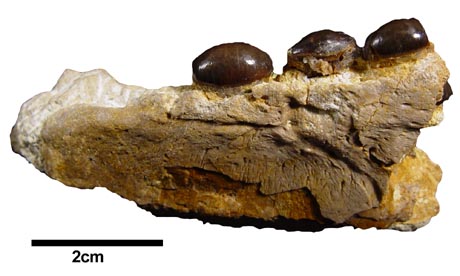
Life reconstruction of Omphalosaurus nevadianus. Artwork copyright © Dmitry Bogdanov - deviant art
| Diapsida | ||
| The Vertebrates | Omphalosauria |
| Vertebrates Home | Vertebrate | Vertebrate |
|
Abbreviated Dendrogram
Amniota
├─Synapsida
└─Sauropsida
├─Anapsida
└─Eureptilia
└─○Diapsida
╞═Araeoscelida
└─○Neodiapsida
╞═"Younginiformes"
└─┬─Claudiosaurus
└─┬─Weigeltisauridae
└─┬─┬─Thalattosauria
│ └─Ichthyosauria
├?─Omphalosaurus
├?─Saurosphargidae
├?─Hupehsuchia
└─○Sauria
├?─Choristodera
├─Lepidosauromorpha
└─Archosauromorpha
|
Contents
Overview |
 Life reconstruction of Omphalosaurus nevadianus. Artwork copyright © Dmitry Bogdanov - deviant art |
The Omphalosaurs are another lineage of those strange Early Triassic marine reptiles that were evolving alongside each other, and often resembled each other, either because they actually were related, or they weren't, but converged (parallel evolution, or homoplasy to give the technical term) with others of similar lifestyle . The Omphalosaurs were quite successful animals; their massive pavement-like teeth (used for feeding on hard shelled animals like molluscs) being known from the Triassic of Nevada, Austria, Spitzbergen, and Spain. Like the Hupehsuchia they resemble ichthyosaurs, with which they may, or may not, be related (we have tentatively placed them as sister group (close cousins) to primitive Ichthyosaurs. Because little is known of the complete animal, the above life reconstruction is inevitably tentative. MAK110923
 Speculative reconstruction of Omphalosaurus - From Middle Triassic (Asinian-Ladinian) of Nevada and Germany. About 3 m long. Artwork by Dmitry Bogdanov - Wikipedia. Compare with this and this Japanese reconstruction. |
Omphalosaurus is a type of marine reptile known from the latest Early Triassic to the Middle Triassic, distinguished by its characteristic pavement or button-like teeth, which were clearly used to feed on hard-shelled prey. It is widely distribution in the northern hemisphere, occurring in the eastern Pacific realm, in Spitsbergen, and in the western Tethys, but remains poorly known (Sander & Faber 2003). It was considered as non-ichthyopterygian by Merriam, who disocovered it, a view supported by some, although others assigned it to the Ichthyopterygia (Motani 2000 p.295). Using thecladistic approach it has been argued that Omphalosaurus either is not (Motani 2000), or is (Sander & Faber 2003), an Ichthyopterygian. This question remains unresolved, and its exact position in the diapsid tree is currently unknown.
 Teeth and mandible of Omphalosaurus, © Universität Bremen, original url. |
Omphalosaurus :O. nettarhynchus, O. nevadanus, O. nisseri. (teeth only), O. wolfi.
Early Triassic of Spitsbergen, Middle Triassic of Nevada and Germany.
Neodiapsida ::: Thalattosauria + (Ichthyopterygia + *)
rather elongate snout with crushing dentition placed anteriorly; button-like teeth concentrated along the skull midline, forming a convex upper and concave lower pavement of , set in the premaxillae and the dentaries, respectively (Sander & Faber 2003 ) vertebrae are of the ichthyosaurian type (Sander & Faber 1998)
Comments: A durophagous (mollusc-eating) form, or opossiblya herbivore like Placodus, feeding on seaweed. Originally considered a very primitive ichthyosaur. Cladistic analysis by Motani (2000) showed that similarities with ichthyopterygia are either shared primitive characteristics (symplesiomorphies) or convergences, and that the genus also possesses characters that do not exist in any ichthyopterygians, such as a splenial jaw symphysis. This interpretation was rejected by Sander & Faber 2003, who on the basis of a recently discovered partial skeleton from the earliest Ladinian German Alps argue that Omphalosaurus possesses four synapomorphies placing it within the ichthyosaurs and five characters suggestive of ichthyosaurian affinities. Pending resolution of these conflicting claims, I have in the dendrograms tentatively placed Omphalosaurus near the stem of the ichthyopterygian line, but outside the Ichthyopterygia itself. Alternatively, Omphalosaurs may be related to Sauropterygia or Archosauromorphs (Motani 2000 pp.299-300)
Links: Dinosaurs about com Omphalosaurus wolfi (fossil), Sea saurian (in German); Wikipedia, speculative reconstruction - Japanese website, speculative reconstruction and text (in Japanese)
Systematic paleontology:
Further species:
Omphalosaurus nettarhynchus Mazin & Bucher, 1987, Middle Triassic, Nevada
Omphalosaurus peyeri Maisch & Lehmann, 2002, Middle Triassic, Germany; (= Pessopteryx nisseri Wiman, 1910 (partim) chimera, postcrania belong to true ichthyosaur )
Omphalosaurus wolfi Tichy, 1995, Middle Triassic, Germany. ( = O. nevadanus?)
Omphalosaurus merriami Maisch, 2010, Middelhook, Isfjord, Svalbard. Sticky Keep Formation, Lower Triassic.
page last modified MAK110923